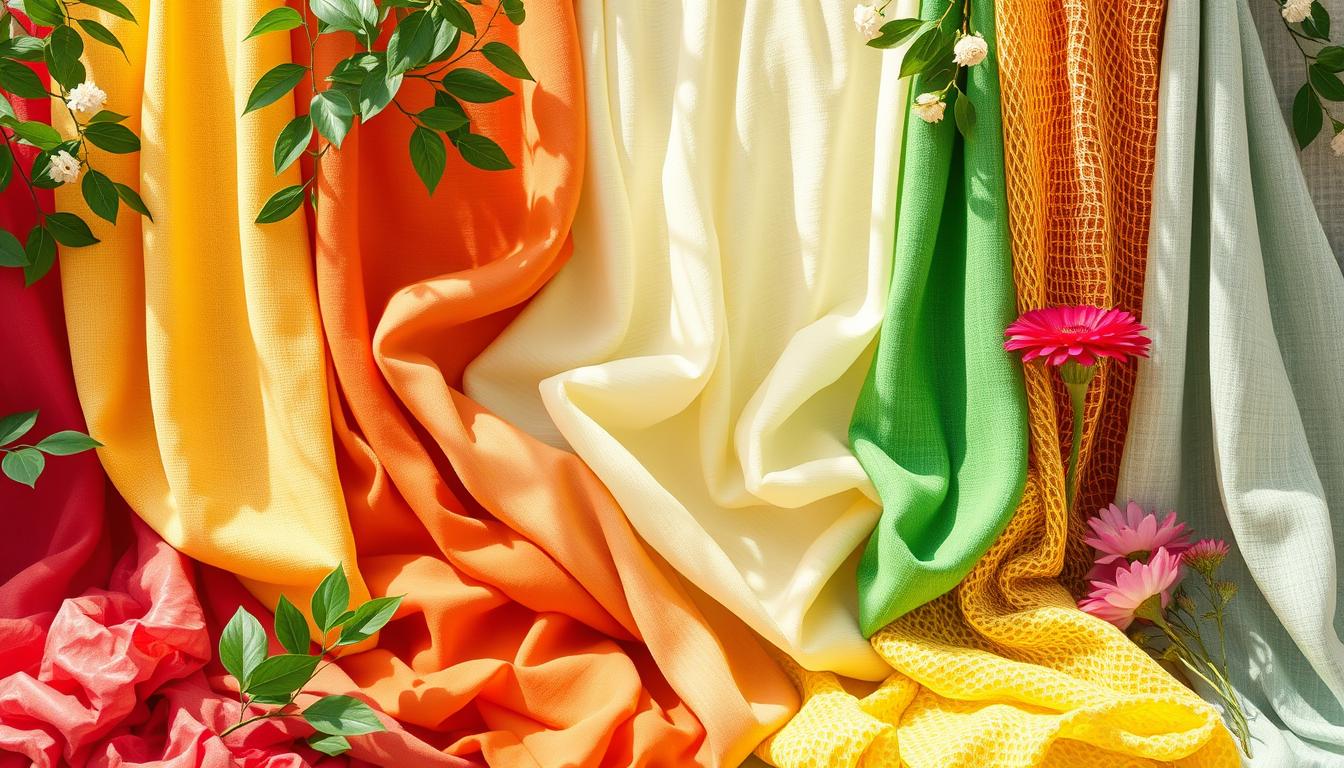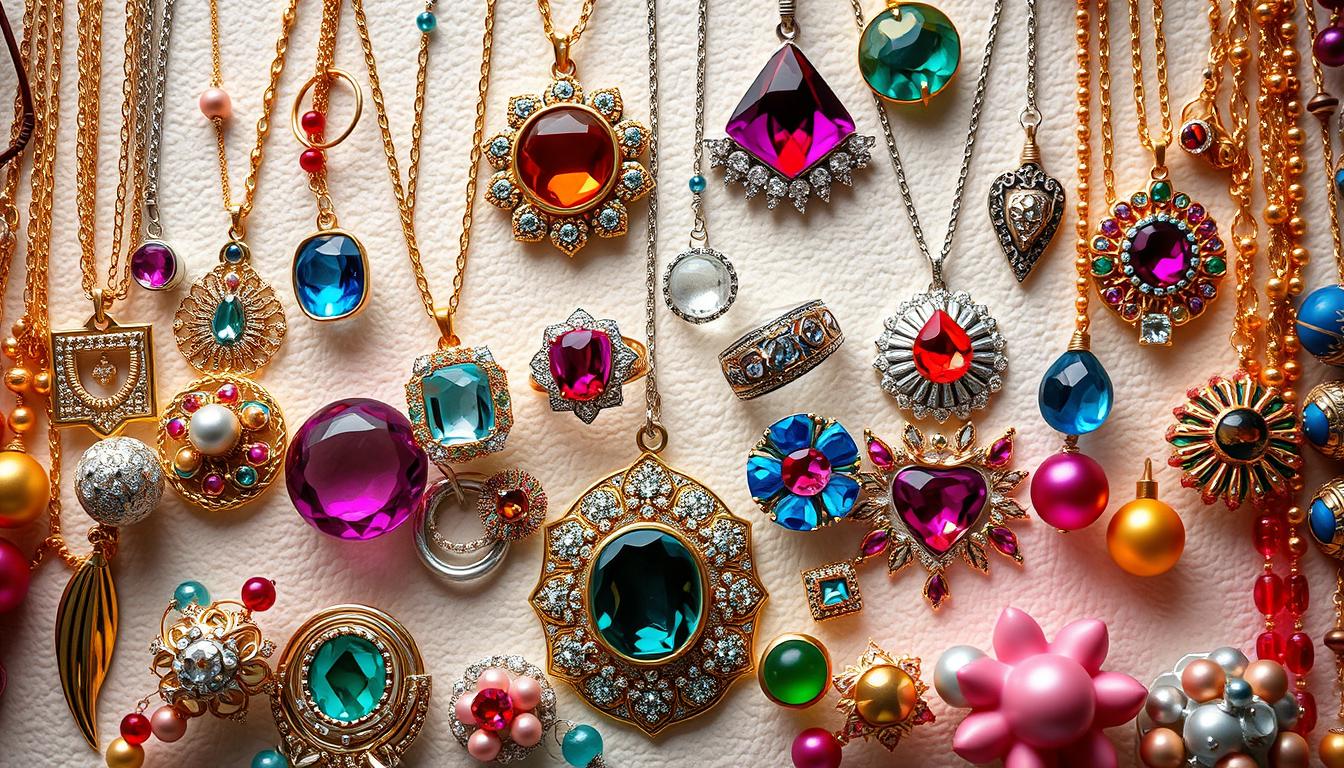We’re excited to dive into the future of fashion and the role of sustainable fabrics. We’ll talk about the latest in sustainable fabric tech. This includes eco-friendly textiles and modern materials that are reshaping fashion design.
Innovative sustainable fabrics are key in fashion today. We’ll explore modern materials that help the environment. Eco-friendly textiles are leading to a big drop in the fashion industry’s carbon footprint.
Our aim is to give a full guide on sustainable fabrics and their impact on fashion. By using these fabrics, we can make fashion more sustainable for the future.
Introduction to Sustainable Fabrics
We’ll look at the newest trends and innovations in sustainable fabrics. This includes recycled materials, biodegradable fabrics, and plant-based textiles. By understanding these materials, we can see how sustainable fabrics can change fashion.
Key Takeaways
- Innovative sustainable fabrics are changing the face of fashion design
- Eco-friendly textiles are reducing the fashion industry’s carbon footprint
- Modern sustainable materials are becoming increasingly important
- Sustainable fabrics have the power to revolutionize the fashion industry
- Recycled materials, biodegradable fabrics, and plant-based textiles are leading the way in sustainable fabric technology
- The use of sustainable fabrics can create a more sustainable future for fashion
The Need for Sustainability in Fashion
The fashion industry is one of the biggest polluters worldwide. It’s time to adopt sustainable practices. Forward-thinking textiles can help reduce the industry’s harm to the environment.
Organic cotton and recycled materials are gaining popularity. These sustainable fabrics cut down on waste and offer eco-friendly alternatives. The benefits of sustainable fashion include:
- Reduced carbon footprint
- Conservation of water and energy
- Decreased waste and pollution
As people learn about the environmental impact of their choices, demand for eco-friendly fashion grows. We’ll see more brands using sustainable materials. This will help make the fashion industry more sustainable for the future.
Innovations in Sustainable Fabric Technology
The fashion world is changing fast, moving towards contemporary eco-conscious fabrics. These fabrics cut down on environmental harm and open up new design paths. Green fashion design materials are key for brands wanting to do good.
New fabrics are made from biodegradable stuff, recycled materials, and plants. They’re good for the planet and make clothes better in many ways.
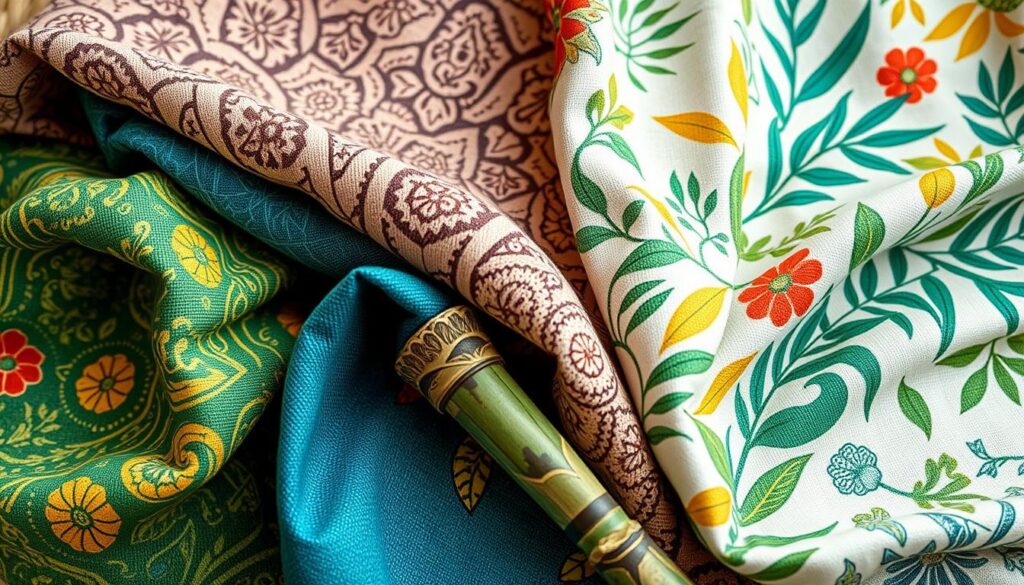
Biodegradable Fabrics
Biodegradable fabrics come from natural stuff that breaks down easily. This cuts down on waste in landfills and oceans. It’s a big step for fashion to be kinder to the earth.
Recycled Materials in Fashion
Recycled materials are big in fashion now. Brands use recycled polyester and more to make new clothes. It saves resources and cuts down on waste.
Plant-Based Textiles
Textiles from plants like hemp, bamboo, and organic cotton are getting popular. They need less chemicals, water, and energy to make. This makes them a great choice for those who care about the planet.
A Closer Look at Organic Cotton
Organic cotton is a top pick for those who care about the planet. It’s a smart choice to lessen our environmental impact. Organic farming means no harmful pesticides or synthetic fertilizers. This makes the air and soil healthier for farmers and us.
Organic cotton takes more work to make, but it’s worth it. It’s made from materials that are good for the Earth and soft on our skin. Organic cotton has many benefits, like:
- Less exposure to harmful chemicals
- Better soil health
- Higher crop yields
- Support for fair labor
Organic cotton is a better choice than regular cotton. By picking eco-friendly options, we help the planet. 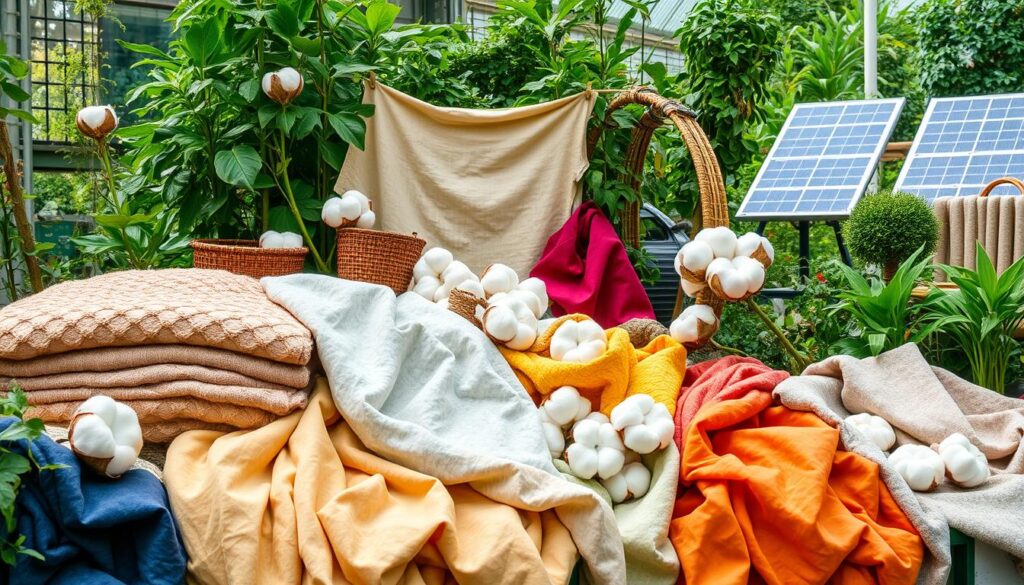
Exploring Tencel and Lyocell
We’re excited to explore Tencel and Lyocell, two innovative fabrics in the fashion world. They are stylish and eco-friendly, perfect for those who love the planet.
Tencel and Lyocell are leading the way in sustainable fashion. They’re made from wood pulp cellulose, which is very sustainable. Their production uses closed-loop systems, cutting down on waste and environmental harm.
What Makes Tencel Sustainable?
Tencel’s sustainability comes from using renewable resources and a closed-loop process. This method greatly reduces waste and environmental impact. Plus, it’s biodegradable, making it a top choice for eco-friendly fashion.
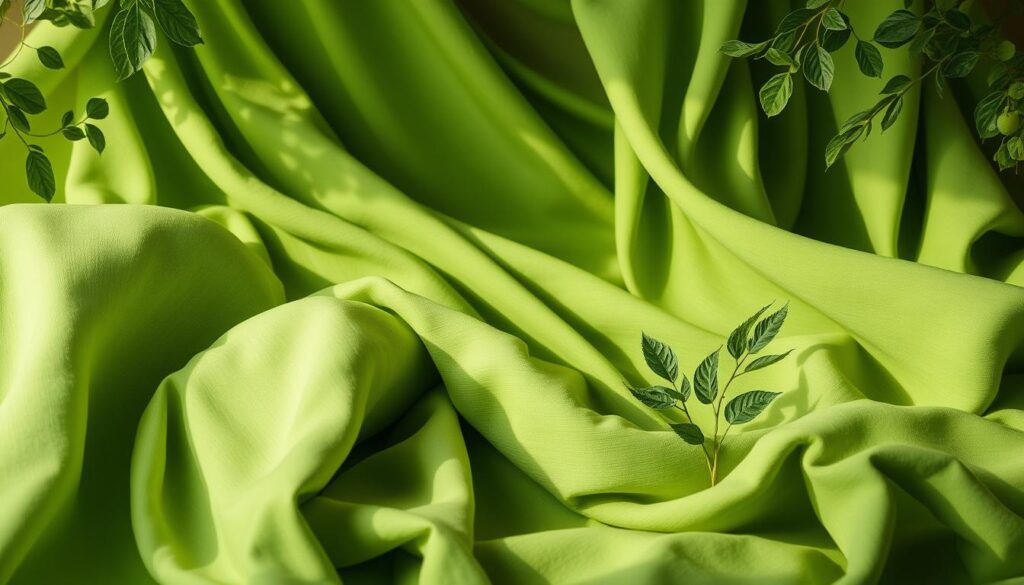
The Production Process
The making of Tencel and Lyocell involves several steps, from getting wood pulp to treating fibers. It’s designed to be green, using little water and energy. This results in a fabric that’s sustainable, soft, breathable, and long-lasting.
Use Cases in Fashion Design
Tencel and Lyocell are great for many fashion designs, from casual to formal. Their special qualities make them perfect for stylish, sustainable clothes. As fashion evolves, we’ll see even more creative uses of these fabrics.
The Rise of Performance Fabrics
The fashion world is changing fast, with innovative sustainable fabrics becoming more popular. This is thanks to people wanting to help the planet. They’re looking for eco-friendly textiles in the athleisure market. This shift is because of the need for modern sustainable materials that are good for the planet and perform well.
Performance fabrics are known for being moisture-wicking and breathable. These qualities are key for activewear. They keep you cool and dry, perfect for sports and outdoor activities. Using innovative sustainable fabrics in these clothes helps reduce the fashion industry’s carbon footprint.
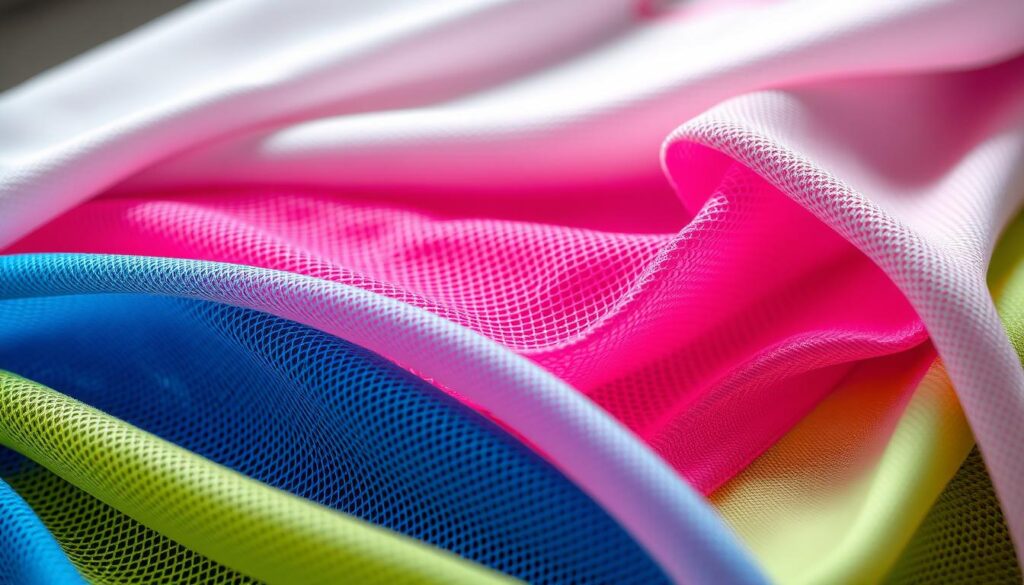
Innovative Textiles for Athleisure
New eco-friendly textiles have led to better athleisure wear. These fabrics are comfy, flexible, and last long while being kind to the environment. Examples include recycled polyester, organic cotton, and plant-based materials.
Moisture-Wicking and Breathable Fabrics
Moisture-wicking and breathable fabrics are key for performance wear. They pull sweat away and let air in, keeping you cool and dry. Innovative sustainable fabrics like bamboo and hemp are making these fabrics both comfy and green.
Durability Meet Sustainability
The fashion world is moving towards being more sustainable. It’s focusing on making clothes that last and are good for the planet. Modern sustainable materials are being made to meet this need. By choosing eco-friendly textiles, we can help make fashion more sustainable.
The Impact of Vegan Leather
The fashion world is changing fast, with more people wanting sustainable and eco-friendly stuff. Vegan leather is a big hit, being a green alternative to real leather. It’s made from things like polyurethane, polyvinyl chloride, and even mushroom or pineapple-based fabrics.
Vegan leather helps the planet by cutting down on greenhouse gases and using less water. It also makes less waste. Plus, it’s often recycled, which means we use less new stuff and throw away less. More and more, people are choosing green fashion, like vegan leather, for clothes and accessories.
Big names in fashion are now using vegan leather in their designs. This includes both fancy and affordable brands. They’re making clothes and accessories that are stylish and good for the planet. You can find vegan leather in:
- Vegan leather handbags
- Vegan leather shoes
- Vegan leather jackets
As we learn more about how our choices affect the planet, we’ll want more eco-friendly stuff. By picking vegan leather and other green materials, we help make fashion better for our world.
| Material | Environmental Benefits |
|---|---|
| Vegan Leather | Reduced greenhouse gas emissions, lower water consumption, minimal waste generation |
| Recycled Materials | Reduced need for new raw materials, minimized waste |
| Plant-Based Materials | Biodegradable, non-toxic, sustainable |
Upcycling: Making the Most of Existing Materials
We’re excited to dive into the upcycling trend in fashion. It’s all about turning old materials into something new and unique. This way, we cut down on waste and use eco-friendly stuff. Upcycling helps make fashion more circular, good for both people and the planet.
Upcycling is already changing the game. Fashion brands are now making clothes from recycled stuff. Designers are also trying out new, sustainable fabrics to create amazing pieces. These moves show upcycling’s power to make fashion greener.
The Benefits of Upcycling
- Reduces waste and supports the use of eco-friendly textiles
- Promotes the use of modern sustainable materials and innovative sustainable fabrics
- Encourages creativity and innovation in fashion design
As we keep exploring upcycling, we see its huge impact on fashion. By using what we already have, we can make fashion more sustainable.
Challenges in Implementing Sustainable Practices
We’re trying to make the fashion industry more eco-friendly, but it’s tough. One big problem is the cost of forward-thinking fashion textiles and environmentally-friendly fashion fabrics. These materials are pricier to make, which makes it hard for brands to use them without raising prices.
Finding cutting-edge sustainable textiles is another hurdle. Brands often use complex global supply chains. This makes it hard to know where their materials come from. To solve this, brands can team up with suppliers who care about the planet. For instance, sustainable design in fashion can cut down on waste and pollution.
Getting people to care about sustainable fashion is key. When consumers understand the value of forward-thinking fashion textiles and environmentally-friendly fashion fabrics, they can choose better. Here are some tips for shoppers:
- Look for certifications like GOTS or Oeko-Tex
- Check the brand’s sustainability policies
- Opt for quality over fast fashion
By tackling these issues together, we can make fashion more sustainable. This will help both people and the planet.
The Importance of Certifications
Certifications play a big role in the world of sustainable fabrics. They help make sure materials are good for the planet and people. When you’re looking for clothes made from eco-friendly materials, check for these certifications.
Certifications like GOTS and Oeko-Tex mean the fabrics are safe and green. They help brands show they care about the planet. This makes them look better in the eyes of customers.
Some important certifications to watch out for are:
- GOTS (Global Organic Textile Standard)
- Oeko-Tex
- Bluesign
These certifications mean the fabrics are made with care for the environment and people. They ensure the materials are top-notch.
Choosing clothes with these certifications helps make fashion better. As shoppers, we can push for a greener industry. By supporting eco-friendly brands, we make a difference.
| Certification | Standard | Benefits |
|---|---|---|
| GOTS | Organic textile standard | Ensures environmental and social responsibility |
| Oeko-Tex | Safety standard | Guarantees safe and sustainable production |
| Bluesign | Environmental standard | Promotes sustainable production and reduces waste |
The Future of Sustainable Fabrics in Fashion
The fashion world is changing fast, moving towards sustainable fabrics and eco-friendly textiles. This shift aims to make fashion more responsible. The future looks bright with new sustainable materials.
Innovations on the Horizon
Exciting changes are coming, like biodegradable fabrics and recycled materials. Brands are working with fabric innovators to lead the way in sustainable fashion.
How We Can Support Sustainable Fashion
We all have a part to play in making fashion more sustainable. By choosing eco-friendly options and supporting sustainable brands, we can help change the industry.
Collaborative Efforts in the Industry
Creating a greener fashion world needs everyone’s help. It’s great to see leaders and designers working together. Their efforts are promising for a better future.
By embracing sustainable fabrics, eco-friendly textiles, and modern sustainable materials, we can make fashion both stylish and green.

